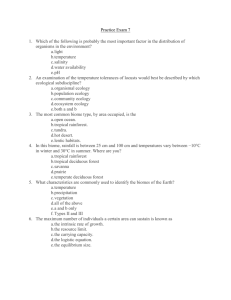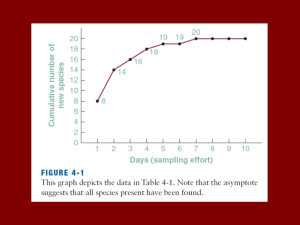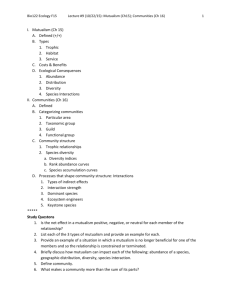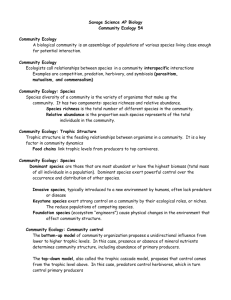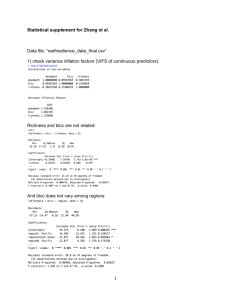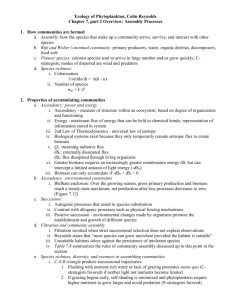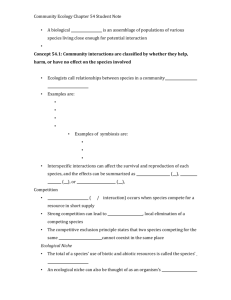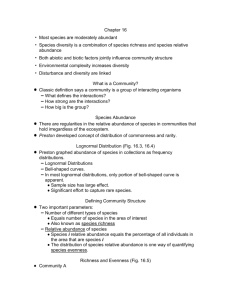Practice Exam 5
advertisement
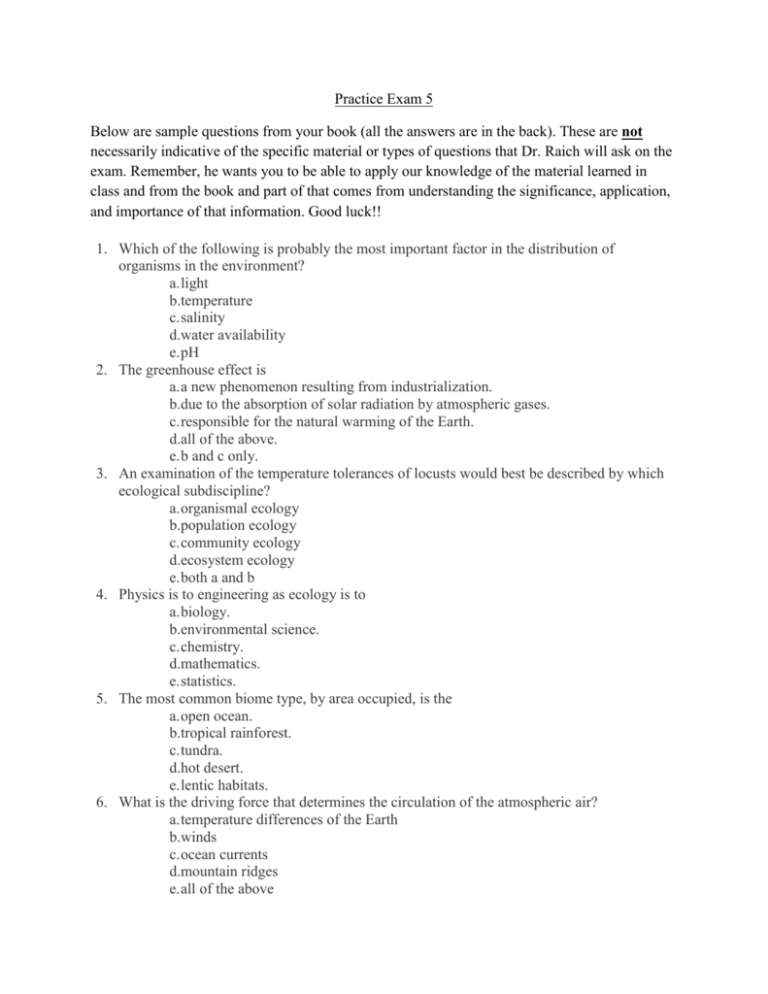
Practice Exam 5 Below are sample questions from your book (all the answers are in the back). These are not necessarily indicative of the specific material or types of questions that Dr. Raich will ask on the exam. Remember, he wants you to be able to apply our knowledge of the material learned in class and from the book and part of that comes from understanding the significance, application, and importance of that information. Good luck!! 1. Which of the following is probably the most important factor in the distribution of organisms in the environment? a. light b.temperature c. salinity d.water availability e. pH 2. The greenhouse effect is a. a new phenomenon resulting from industrialization. b.due to the absorption of solar radiation by atmospheric gases. c. responsible for the natural warming of the Earth. d.all of the above. e. b and c only. 3. An examination of the temperature tolerances of locusts would best be described by which ecological subdiscipline? a. organismal ecology b.population ecology c. community ecology d.ecosystem ecology e. both a and b 4. Physics is to engineering as ecology is to a. biology. b.environmental science. c. chemistry. d.mathematics. e. statistics. 5. The most common biome type, by area occupied, is the a. open ocean. b.tropical rainforest. c. tundra. d.hot desert. e. lentic habitats. 6. What is the driving force that determines the circulation of the atmospheric air? a. temperature differences of the Earth b.winds c. ocean currents d.mountain ridges e. all of the above 7. In this biome, rainfall is between 25 cm and 100 cm and temperatures vary between −10°C in winter and 30°C in summer. Where are you? a. tropical rainforest b.tropical deciduous forest c. savanna d.prairie e. temperate deciduous forest 8. What characteristics are commonly used to identify the biomes of the Earth? a. temperature b.precipitation c. vegetation d.all of the above e. a and b only 9. Which gas contributes most to human-caused global warming? a. carbon dioxide b.nitrous oxide c. sulfur dioxide d.methane 10. survivorship curves are usually associated with organisms that have high mortality rates in the early stages of life. a. Type I b.Type II c. Type III d.Types I and II e. Types II and III 11. If the net reproductive rate (R0) is equal to 0.5, what assumptions can we make about the population? a. This population is essentially not changing in numbers. b.This population is in decline. c. This population is growing. d.This population is in equilibrium. e. none of the above 12. The maximum number of individuals a certain area can sustain is known as a. the intrinsic rate of growth. b.the resource limit. c. the carrying capacity. d.the logistic equation. e. the equilibrium size. Questions 8 and 9 refer to the following generalized growth patterns as plotted on arithmetic scales. Match the following descriptions with the patterns indicated below. Each pattern may be used once, more than once, or not at all. 13. Which pattern is found where a population exhibits a constant per capita growth rate? a. A b.B c. C d.D e. none of the above 14. Which pattern is found where a population is heading toward extinction? a. A b.B c. C d.D e. none of the above 15. The amount of land necessary for survival for each person in a sustainable world is known as a. the sustainability level. b.an ecological impact. c. an ecological footprint. d.survival needs. e. all of the above. 16. A community with many individuals but few different species would exhibit a. low abundance and high species complexity. b. high stability. c. low species richness and high abundance. d. high species diversity. e. high abundance and high species richness. 17. Which of the following statements best represents the productivity hypothesis regarding species richness? a. The larger the area, the greater the number of species that will be found there. b. Temperate regions have a lower species richness due to the lack of time available for migration after the last ice age. c. The number of species in a particular community is directly related to the amount of available energy. d. As invertebrate productivity increases, species richness will increase. e. Species richness is not related to primary productivity. 18. Extreme fluctuations in species abundance a. lead to more diverse communities. b. are usually seen in early stages of community development. c. may increase the likelihood of extinction. d. have very little effect on species richness. e. are characteristic of stable communities. 19. Which of the following statements best represents the relationship between species diversity and community disturbance? a. Species diversity and community stability have no relationship. b. Communities with high levels of disturbance are more diverse. c. Communities with low levels of disturbance are more diverse. d. Communities with intermediate levels of disturbance are more diverse. e. Communities with intermediate levels of disturbance are less diverse. 20. Early colonizers excluding subsequent colonists from moving into a community is referred to as a. facilitation. b. competitive exclusion. c. secondary succession. d. inhibition. e. natural selection 21. A tree falls in a forest in spring and flowers germinate in the light gap. Following a tree fall in autumn, different species of flowers germinate in the light gaps. This illustrates the principle of a. facilitation. b. tolerance. c. inhibition. d. primary succession. e. climax communities. 22. A species interaction in which one species benefits but the other species is unharmed is called a. mutualism. b. amensalism. c. parasitism. d. commensalism. e. mimicry. 23. Two species of birds feed on similar types of insects and nest in the same tree species. This is an example of a. intraspecific competition. b. interference competition. c. exploitation competition. d. mutualism. e. none of the above. 24. According to the competitive exclusion hypothesis, a. two species that use the exact same resource show very little competition. b. two species with the same niche cannot coexist. c. one species that competes with several different species for resources will be excluded from the community. d. all competition between species results in the extinction of at least one of the species. e. none of the above is correct. 25. Divergence in morphology that is a result of competition is termed a. competitive exclusion. b. resource partitioning. c. character displacement. d. amensalism. e. mutualism. 26. The amount of energy that is fixed during photosynthesis is known as a. net primary production. b. biomagnification. c. trophic-level transfer efficiency. d. gross primary production. e. production efficiency. 27. Chemoautotrophic bacteria are a. primary consumers. b. secondary consumers. c. tertiary consumers. d. primary producers. e. decomposers. 28. When considering the average food chain, which of the following statements is true? a. Secondary consumers are the most abundant organisms in an ecosystem. b. The more lengths in the food chain, the more stable the ecosystem. c. Biomass decreases as you move up the food chain. d. The trophic level with the highest species abundance is usually the primary producers. e. All of the above are true. 29. Primary production in aquatic systems is limited mainly by a. temperature and moisture. b. temperature and light. c. temperature and nutrients. d. light and nutrients. e. light and moisture. 30. The net primary production of cultivated land is closest to that of a. prairies. b. tropical rain forest. c. wetlands. d. temperate deciduous forest. e. lakes and streams. 31. Terrestrial primary producers acquire the carbon necessary for photosynthesis from a. decomposing plant material. b. carbon monoxide released from the burning of fossil fuels. c. carbon dioxide in the atmosphere. d. carbon sources in the soil. e. both a and d. 32. Nitrogen fixation is the process a. that converts organic nitrogen to ammonia. b. by which plants and animals take up nitrates. c. by which bacteria convert nitrate to gaseous nitrogen. d. by which atmospheric nitrogen is converted to ammonia or ammonium ions. e. all of the above
